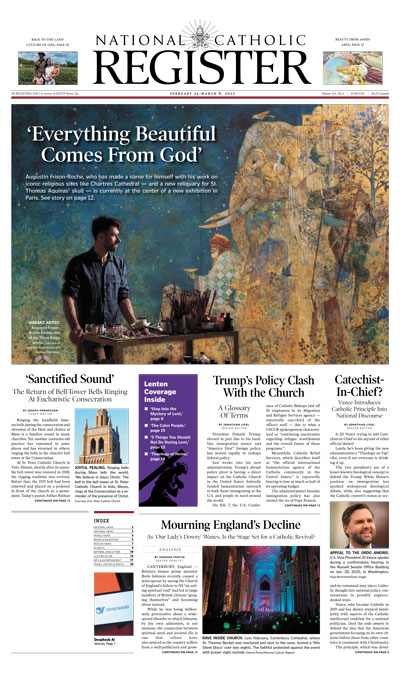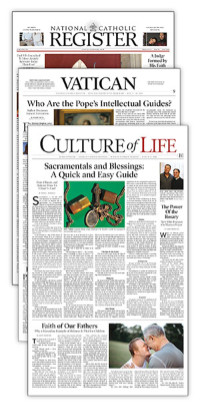Holy Saturday: ‘Fear Being Transformed Into Hope’
Dominican Sister Mary Madeline Todd reflects on ‘The Dead Appear in the Temple’ art by James Tissot.

Editor’s Note: The following excerpts are from “The Art of Holy Week” segment on Register Radio’s March 29, 2025, episode.
Register Radio host Matthew Bunson, vice president and editorial director of EWTN News, was recently joined by Dominican Sister Mary Madeline Todd, of the Congregation of St. Cecilia, who serves as assistant professor of theology at Aquinas College in Nashville, Tennessee, to discuss the print feature in the April 6, 2025, issue of the Register and featured online here.
“We chose some of the artwork of the notable French artist Jacques Tissot, who died in 1902, and his extraordinary collection of paintings on ‘The Life of Christ.’ He was known for his paintings of European high society, especially during the latter part of the 19th century. However, in 1885, he experienced a very profound religious conversion at the Church of Saint-Sulpice in Paris — inspiring him to focus his work on the sacred, notably the life of Christ,” Bunson explained of the Register’s coverage. “His series of more than 350 illustrations were bought by the Brooklyn Museum in 1900.”
“The Register is delighted to present five of Tissot’s works that reflect Christ’s path to Calvary, with reflections on each day from some of our favorite writers,” he continued.
As he welcomed Sister Mary Madeline, Bunson invited her to reflect on “the relationship between truth and beauty.”
“And that’s a wonderful interface,” Sister Mary Madeline replied, “and it’s fascinating. If we study Church history, that back when there was the huge controversy about iconoclasm, the idea of, should there be the use of images within our churches, within worship and even in our personal prayer. And you know, when that was really addressed by the saints, especially St. John Damascene, the idea was, we look at the incarnate Christ, right? ‘The Word became flesh and dwelt among us.’ And that's really the theological reason. We can say that making visible the mysteries of God, making visible grace, which we see, of course, in our churches, in the sacramental system, but also includes the representation of these great mysteries of our faith. And for me, personally, I found that not only in my teaching, for example, when I teach Christology, as I’m studying different doctrines of the life of Christ, I go through artwork from the earliest centuries of Christianity to show kind of the evolution of the representation of Christ and unpack what that means for our faith. But then also, I also am in a ministry of helping people use art in retreat work, in what we call visio divina, praying the Scriptures with beautiful art to really unpack the word of God.”
“You’ve just said something that I think may not be familiar with a lot of our listeners,” Bunson said. “We think of lectio divina, but visio divina is something really quite interesting. Could you talk a little bit more about that?”
“Yes, it’s beautiful, this tradition of lectio divina in the Church, which is, you know, divine or sacred reading. But there’s also this tradition of visio divina, that holy, divine looking, gazing. And you know, when we think about even when Christ was transfigured, for example, on Mount Tabor, how seeing the Risen Lord in his glory really transformed the hearts of his apostles and strengthened them to face the Passion. So there’s both in the East and the West — maybe a little bit more pronounced in the Eastern Churches, because people see icons as such a portal to faith and prayer — but we have such a rich tradition of sacred art in the Western Church, as well, and using art to enter into the mystery of God's word, art that perfectly accompanies and compliments, really, the written word. I find that it’s extremely beautiful.”
The Dominican went on to highlight the importance of beauty in sharing the truth of faith.
“And Cardinal [Joseph] Ratzinger had said earlier in one of his writings that at this moment in the Church’s history, more than anything, we need to preach the truth through beauty. And he named two different specific ways. The beauty is opening people to God, which is through sacred art itself, and through the beauty of the lives of the saints.”
“And as someone who’s called into ministry of teaching and preaching and retreat leading, I find that’s really true, that you can enter into and kind of pierce the heart differently through beauty … than without each other. So it’s a beautiful interface, and I think it speaks to the mind and the heart of the believer,” she added.
The conversation turned back to focus on the work of Tissot, with Sister Mary Madeline explaining her background knowledge of his work: “I had encountered his art before, and I’ve actually used it in the context of offering retreats on the mysteries of the life of Christ before, but, interestingly, I had looked at him more in other scenes like the Presentation and Finding in the Temple, because I often was leading retreats on mysteries of the Rosary or the woman anointing the feet of Jesus in the house of Simon the Pharisee. And so I was familiar with some of his work. I did know that he had done an entire series on the life of Christ.”
She also addressed the conversion of the artist. “I also love his art because it’s coming out of a deep conversion of his own heart. I knew some of his backstory, but in actually being invited into doing this article, I learned more because I really wanted to understand more. … I knew he had gone to the Holy Land to study and pray there so that his artwork would be more realistic, and you see that in some of the paintings that were chosen for this series. But I also wanted to know a little more about his heart, kind of what opened him to want to paint so much the life of Christ, because I knew his earlier career was more high fashion and high society in London and Paris, paintings of great ladies’ elegance.”
“But when I realized that after a lot of personal loss in his own life, he actually had a religious experience, and in the Church of Saint-Sulpice in Paris, had this vision of Christ — when the priest had elevated the consecrated Host at Mass, he saw Christ in his suffering, Christ bleeding with the poor, and he ended up painting that actual vision he had,” she said.
“And then that kind of became a conversion and opening to him, desiring to depict the entire cycle of what we know of Christ’s life from the Scripture. So I was thrilled that the Register chose this artist, because I think, you know, in his own personal pain and loss, in a space where he was kind of struggling in his own Good Friday, the Lord really broke into his life in a beautiful way. And then this art is flowing from, after that reawakening of faith. So I really hope for the readers of the paper who are looking at these meditations, it can be an occasion of great grace.”
“That’s right,” Bunson said. “And when we look at the individual pieces that have been chosen, the one that you reflected on — of The Dead Appear in the Temple — I think of all of these, this is certainly the most striking. So in a nutshell — I don’t want to give too much away, because everyone should read the newspaper — but what was your initial thought when you were offered this one to contemplate?”
“I have to admit that I first thought, ‘What in the world?’ I was like, ‘What is even going on?’ This is such an unusual painting; I’m used to more explicit scenes of the life of Christ,” she replied, adding, “but then the invitation to write about it turned into a beautiful invitation, because it really gave me a space to ponder why, really only one of the Four Evangelists even talks about this scene. And, really, even the fact that it’s in the Scriptures, that this event of after the death of Christ on the cross, but before the Resurrection, there’s this opening of the tombs of the dead, and then in the painting, seeing … the fleeing of the priests of the Old Covenant, this kind of fear in them, but really kind of pondering how Holy Saturday is that transition between the loss of the personal friends of Jesus mourning his death; the faith community, in some ways, being invited into a whole new space. And I think that this painting really is a little bit of a depiction of fear being transformed into hope.”
The Dominican then referenced the 2025 Jubilee.
“And I think especially in this year of the Jubilee of Hope, it’s something worth pondering.”
She went on the explain that she has furthered reflected on and prayerfully studied this art.
“And then, even after I wrote the reflection, I was doing some more looking at the painting, praying about it, and I noticed something that I didn’t even write about in it, that’s really significant, because one of the features of James Tissot is he spent three different extended periods in the Holy Land looking at these spaces and places to try to create archeological realism in a painting. And you’ll see that in these different paintings.
“But in this one, they’re around the altar, and you see one of the altar horns, actually two of the horns of the altar; and in the Hebrew Scriptures, we’re told that the horns on the altar — this was the altar of Holocaust, the altar of burnt offering. And as I did a little more research, even after writing the article, I found out that when sacrifices were being offered, the blood was sprinkled on those horns, and the Jewish people saw this as a sign of cleansing and atonement, and that, if you were in like political danger, if you went to the Temple and you grabbed onto those horns, it was considered a place of refuge and asylum.”
“And I thought, ‘Wow, this is even more meaningful than I realized’ — that, you know, Christ’s Blood shed for us on Good Friday is that cleansing and atonement and, then, that awakening to the gift of new life,” Sister Mary Madeline explained.
“So I think, for me, this painting is an invitation to go from fear of the kind of almost transcendental or supernatural kind of eeriness of the painting into that space of real hope. Because, as we’re told in the Scriptures, the tombs were opened, and then once Christ rose from the dead, then they were seen to appear to many. And they became harbingers, really, of the Resurrection. And so fear was transformed into hope.”
- Keywords:
- holy saturday
- holy week














